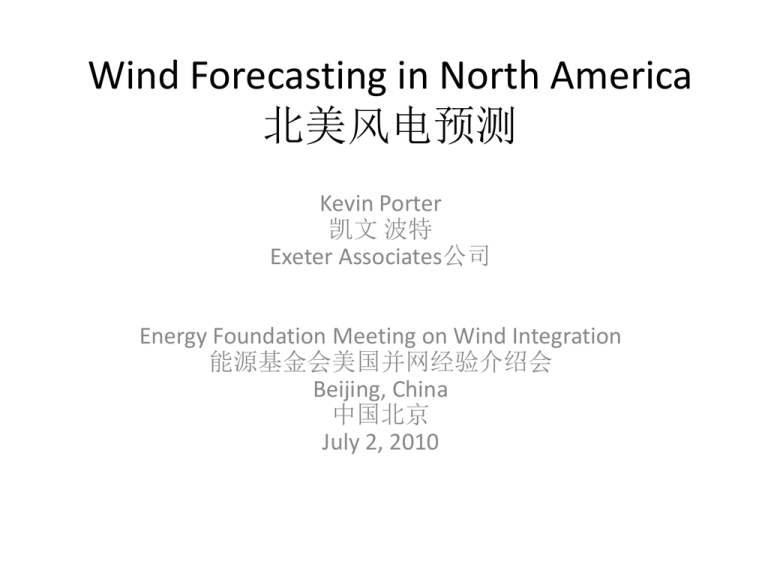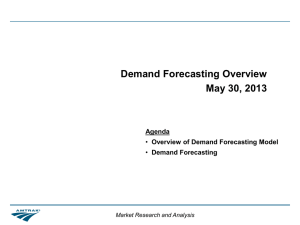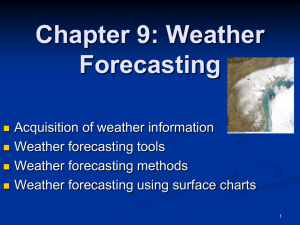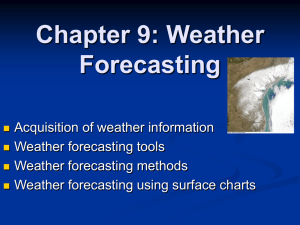Wind Forecasting in North America
advertisement

Wind Forecasting in North America 北美风电预测 Kevin Porter 凯文 波特 Exeter Associates公司 Energy Foundation Meeting on Wind Integration 能源基金会美国并网经验介绍会 Beijing, China 中国北京 July 2, 2010 The Value of Wind Forecasting 风电预测的价值 • Historically in U.S., wind generation simply “show up” and grid operators take the necessary measures to incorporate it • 起初,风电作为新生事物出现,电网运营商采取措施接纳 • Wind forecasting vital at higher levels of wind penetration to cope with uncertainty of when and how much to expect from wind • 风电比重增加后,预测对于应对风电何时出力、发电量多少的不确定 性问题上很必要 • Wind forecasts can reduce costs through better unit commitment decisions, reduced fuel consumption and lower emissions from fossil fuel plants if factored into day-ahead scheduling commitment. • 预测可以通过调度计划/供应合约来降低成本,减少常规电厂的燃料 消耗,节能减排 Wind Forecasting Can Save Money… 风电预测能够帮助省钱… Projected Annual Operating Cost Savings Peak Load Wind Generation State-of-Art Forecast vs. No Forecast Additional Savings from Perfect Forecast vs. State of Art Forecast California 64 GW 64 GW 7.5 GW 12.5 GW $ 68 M 160 M $19 M 38 M New York 33 GW 3.3 GW 95 M 25 M Texas 65 GW 65 GW 65 GW 5.0 GW 10.0 GW 15.0 GW 20 M 180 M 510 M 20 M 60 M 10 M Source: Piwko 2009. Importance of Wind Forecasting Being Widely Recognized 风电预测得以广泛认可的意义 • “enhanced measurement and forecasting of variable generation output is needed to ensure bulk power system reliability,” and that wind forecasting “must be incorporated into real-time operating practices as well as day-to-day operational planning” (NERC) • “The seamless integration of wind plant output forecasting—into both power market operations and utility control room operations—is a critical next step in accommodating large penetrations of wind energy in power systems” (DOE 20% report) • “加强对发电输出变 量的测量和预测对于 确保电力系统安全运 行十分必要,” 因此风 电预测“必须纳入实 时和日常运行规划” (NERC) • “风电场出力预测— 在电力市场运行和电 力公司控制室运行中 发挥作用—是帮助电 力系统加大风电接入 比重的关键一步” (美 国能源部 20% 报告) Central Wind Forecasting Taking Hold… 集中式预测为主导… • In some markets, wind generators are required to offer a wind power forecast to the power purchaser or to the grid operator • Central wind forecasting is becoming more prevalent • Central wind forecasts are administered for multiple wind generators by a utility or transmission operator, typically with the assistance of a wind power forecasting company • 在一些国家和地区的市 场中,风电供应商被电 力收购商和电网运行商 要求提供预测 • 集中式风电预测渐成主 流 • 集中式风电预测,由电 力公司和电力传输/配 送运营商实施,通常雇 专业的风电预测公司开 展工作,能同时管理很 多风电供应商 Wind Forecasting Companies 开展风电预测工作的公司 • At least five companies providing wind forecasts in North America – – – – – 3Tier AWS Truepower WindLogics (subsidiary of NextEra) Energy and Meteo Systems GMBH WePROG • Environment Canada of the Department of Environment in Canada provides wind power forecasts for Hydro Quebec • Separately, the U.S. National Center for Atmospheric Research is developing a wind forecasting tool for Xcel Energy • 北美至少有5家公司能提供风电 预测服务 – – – – – 3Tier AWS Truepower WindLogics (subsidiary of NextEra) Energy and Meteo Systems GMBH WePROG • 加拿大环境部下的单位 “Environment Canada ”为“魁 北克水电”提供风电预测服务 • 美国国家大气研究中心正在为 “Xcel能源”开发风电预测工具 Users of Central Wind Forecasting in North America 北美集中式风电预测的用户 • CAISO • ERCOT • Hydro Quebec • Midwest ISO • Under development at Alberta Electric System Operator, the Bonneville Power Administration, and the Independent Electric System Operator of Ontario. • Generally select wind forecasting companies through request for proposals – CAISO held competition in RFP for wind forecast accuracy • Utilities and RTOs generally pay for the wind forecasts – New York ISO and CAISO assess fees to wind generators to pay for wind forecasts • New York ISO • PJM • Southern California Edison • Xcel Energy • • 阿尔伯塔省电力运行机构辖下 的博纳维尔电力管理局,安大 略省独立电力运行机构 通常通过征集项目建议书选择 风电预测服务商 – 阿尔伯塔省电力运行机构(CAISO) 通过项目建议书征集比选(类似招 标)的办法提高风电预测准确度 • 电力公司和区域输电运营机构 (RTOs)通常要负担风电预测 费用 – 纽约电力调度中心(ISO)和阿尔伯 塔省电力运行机构(CAISO)为风 电供应商评定风电预测的相关费用 Advantages of Central Wind Power Forecasting 集中式风电预测的优势 • Consistent wind • 预测方法统一 forecasting • 风电数据获取渠 methodology 道 • More access to wind • 规模效益降低成 generation data 本 • Can take advantage of economies of scale, which may reduce costs Disadvantages 劣势 • A single wind forecasting methodology may produce “consistently wrong” results • 缺少比对校验,单一的预测方法易造成同 样错误的反复出现 Types of Wind Power Forecasts 风电预测的类型 • Persistence • 持续性预报 – Assumes past value equals – 假设过去值等同未来值 future value – Reasonable accurate for next 1- – 对下一到两个小时而言准 确性还可以,但准确度随 2 hours but accuracy diminishes 时间推移锐减很厉害 quickly over time • Climatological – Long-term or average value – Outperforms persistence further out than 4-6 hours – Actual wind production at any particular time may be far different than climatological forecast • 气候预报 – 长期或平均值 – 超出持续性预报四到六小 时 – 具体时间点上的实际风电 发电量可能与气候预报给 出的数值差距很大 Types of Wind Power Forecasts (2) 风电预测类型(2) • Central wind power forecasts use numerical weather forecast models – Three-dimensional – Rely on physical laws related to atmospheric motion • These types of models have trouble with large-scale weather features that evolve over one-totwo weeks • Used in combination with statistical methods for shortterm (1-2 hours) and long-term (>14 days) • 集中式风电预测使用数 值气象预测模型 – 三维 – 依据大气运动的物理规 律 • 这类模型对长达1-2 周的大范围天气变化 预测准确度较差 • 与统计方法配合运用 进行短期(1-2 小时)和 长期(>14小时)预测 Different Types of Forecasts 风电预测的不同形式 • Hour-ahead wind forecasts • apply updates to generate forecasts as frequently as 5minutes for the next four to six • hours ahead • Day-ahead wind power forecasts provide hourly forecasts for the next two-to-four days and are • typically updated every 6 to 12 hours • Situational awareness wind forecast is used in real time for severe weather events “小时级”风电预测可为 之后的四到六小时提供该 时段每五分钟的出力预测 “日前”风电预测可为之 后的两到四天提供当日每 小时出力预测,一般每612小时进行更新 也有其他类型的风电预测 为应付恶劣气候情况提供 实时预测帮助 Ramp Forecasts 爬坡预测 • Used to predict potential large • swings in wind generation (up and down) • • More challenging than conventional wind forecasting; • subject to large errors • Not in place at most utilities or RTOs in U.S. but expected to be implemented in near future 曾预测潜在风电(上下) 波动 比常规风电预测更有挑战 性; 可能出现大的误差 多数美国电力公司和区域 输电运营组织尚未开展这 项预测,但预计近期就能 开始 Ensemble Forecasts 集合预报 • Involves using multiple wind power forecasting methodologies or providers • May weigh different forecasts based on accuracy in certain weather conditions • Question is whether increase in accuracy justifies higher cost • Germany uses an ensemble wind forecast and found reductions in wind forecast error of 4.2% • California ISO determined no additional value from using multiple wind power forecast vendors unless rate paid to wind power forecasting companies based more on wind forecast accuracy • 采用多种风电预测方法/服务商 • 针对特定天气条件的预测准确 度,可以综合运用不同的预测 方式 • 问题是预测准确度的提高能否 值回付出的额外成本 • 德国采用集合预测的方式,证 明可以降低4.2%的预测误差 • 加州电力调度中心认为,除非 采用与预测准确度直接挂钩的 付费方式,否则不值得雇用多 家风电预测服务商 Average Wind Power Forecast Errors by Time Frame 不同时段范围风电预测平均误差 Forecast Error Single Plant Region 10 – 15% 4–6% 6 – 11% 3–6% 25 – 30% 10 – 12% 15 – 18% 6 – 8% Hour Ahead Energy (% Actual) Capacity (% Rated) Day Ahead Hourly Energy (% Actual) Hourly Capacity (% Rated) Implementation and Design Issues with Central Wind Power Forecasting 集中式风电预测的执行与设计问题 • Who Pays? – CAISO and NYISO charge wind generators for some or all of the wind forecasting costs – Although not finalized yet, Alberta and Ontario have proposed to pass on costs to wind generators – Other RTOs and utilities absorb the costs • 谁来承担费用? – 阿尔伯塔省电力运行机构 (CAISO)和纽约电力调度 中心(ISO)让风电供应商承 担部分或全部预测费用 – 尽管尚未最终确定,但是阿 尔伯塔省和安大略省已经提 议把预测费用的担子交给风 电供应商 – 其他区域输电运营机构和电 力公司则负担了预测费用 Implementation and Design Issues (2) 执行与设计问题 (2) • Data Availability and Quality • 数据取得和质量 – Turbine availability is often – 集中式预测通常假定风机数据获 assumed at 100% in central 得率为100% wind power forecasting models – 预测模型不是总能考虑到风机切 – Reporting of wind turbines 出或弃风情况报告的 being off-line or curtailed have – 风电项目和集中式预测之间的通 not always been incorporated in 讯联系不能保证一直不出问题 wind power forecast models – Communication links between wind projects and the central wind power forecaster have not always functioned well Importance of Quality Data to Central Wind Power Forecast 高质量数据对于集中式风电预测的重要性 Data Requirements for Wind Generators for Input into Wind Forecasts Becoming More Common 对风机出力数据提供的要求比之前加强 • New York ISO requires metrological and plant output data, with daily penalties of the greater of $500 or $20/MW if data is not provided • Other utilities and RTOs also require metrological and plant output data but do not impose penalties • 纽约电力调度中心(ISO) 强制 要求提交气象和电量数据,若不 提供数据,每日罚金按照总额 500美元,或者单位兆瓦20美元 的费率计算,两者取其高 • 其他电力公司和区域输电运营机 构也要求提交气象和电量数据, 但是没有惩罚措施 Data Typically Requested 典型数据 • Metrological data – Wind speed, wind direction, temperature, dew point, humidity, barometric pressure • Wind turbine power curves • Turbine availability • Plant and/or turbine-level power output • Longitude and latitude of wind turbines • Hub height • 气象资料 • 风速、风向、气温、结露 点、湿度、气压 • 风机功率曲线 • 风机可靠性 • 风电场和/或风机的功率输 出 • 风机位置的经纬度 • 轮毂高度 Conclusions from the United States 基于美国经验总结出的结论 • • • • • • Wind power forecasting is seen as an essential tool to help incorporate higher levels of wind generation If properly designed and implemented, wind power forecasting can reduce costs through reduced fuel consumption and emissions Central wind forecasting becoming more widely adopted Several different types of wind power forecasts being utilized Utilities and RTOs generally pay for the forecasts, but not always Data quality affects wind forecast accuracy. As a result, data requirements for wind forecasts becoming more common • 风电预测已经被视为电网吸 纳更大比重风电的一个基本 手段 • 设计、实施得当,风电预测 可以通过减少燃料消耗和排 放降低相对成本 • 集中式风电预测被更广泛的 采用 • 采用几种不同类型的风电预 测方法 • 基本上电网和RTOs来负担预 测费用,但也有特殊情况 • 数据质量决定风电预测的精 确度,因此对数据的要求变 得更为普遍。









